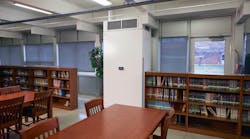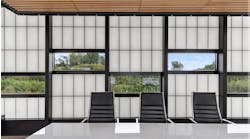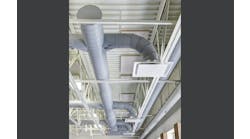For K-12 schools, providing excellent indoor air quality will always be a goal. Covid-19 is no longer dominating the headlines, other airborne pathogens, in addition to spring allergens, continue to be causes for concern. In November 2022, Coffee County and Perry County in Tennessee had to close schools because of widespread illness, according to WKRN-TV. The southeast wasn’t the only area hit hard by a flu outbreak. In Maine, students at Casco Bay High School in Portland were sent home in December because 32% of students and staff members were out sick with the flu, according to ABC News.
Mechanical HVAC units can minimize airborne pathogens that cause K-12 schools so much grief. The summer recess offers K-12 schools an opportunity to carry out the necessary upgrades to their HVAC systems. Systems that are outdated or malfunctioning won’t perform at a rate that results in good indoor air quality (IAQ). The efficiency of a subpar system will erode and the system will be forced to work harder. Summer break gives school systems the time needed to inspect these problems and correct them before students return to the classroom.
HVAC units are a costly item, so it is important for facility managers to make the correct decision: Retrofit the unit to perform better or replace it entirely?
Signs of age
When determining whether to replace or retrofit an HVAC unit, age plays a major role. If a system has become outdated or is hitting the 15- to 20-year mark, replacement may be a better option. If a unit has a motor that is old or worn out, it will have added amp loads. In addition, older filters and dirtier coils will add extra static, which will ultimately put more force on the motor and make it work harder. This not only increases a school’s utility bill, but also may lead to system failure in older HVAC units.
Older HVAC units may not be meeting all the requirements for IAQ. In older systems, if the dampers or economizers aren’t working, it may not be compliant with Standard 62.1. According to ASHRAE, the standard “specifies minimum ventilation rates and other measures intended to provide indoor air quality that’s acceptable to human occupants and that minimizes adverse health effects.”
Trying to retrofit an older HVAC unit to satisfy a school facility’s IAQ needs may be shortsighted if it results in more costly repairs down the line. For a K-12 school with a limited budget, this would not be beneficial. A district could spend money replacing the motor, filters and making upgrades only to have the system go out of service permanently because the compressor or controls malfunctioned. If your HVAC unit is too old, consider replacing it.
If it’s not broke, don’t fix it
If a school’s HVAC unit has been serviced regularly or is less than 15 years old, consider retrofitting the unit with the necessary upgrades to help minimize the spread of airborne pathogens. To improve filtration, adding UV lights or needlepoint bipolar ionization technology can provide an extra layer of protection. UV lights draw untreated air in and push it through a highly reflective UV chamber with an ultraviolet light. This inactivates the bacteria and fungi that pass through the light.
With bipolar ionization, ions collide with particles resulting in a charge that attracts additional particles of opposite polarity. This results in larger particles that are easier to capture in filtration systems. If a system is compatible, upgrading to MERV 13 or 14 filters would help minimize the number of pathogens in the air.
Of course, before making any of the upgrades, it’s important to make the component upgrades to ensure an HVAC system can handle the changes. In some cases, the motors in an HVAC system may not be able to handle the added static. That will result in the motors failing or less airflow because the system wasn’t compatible with the filters. When retrofitting, be sure to take all the proper steps to ensure that an HVAC system is efficient and operating at optimal levels. Overall, retrofitting can be less expensive and take up considerably less time than a full replacement.
The right choice
When school facility managers are deciding whether to retrofit or replace, a critical factor will be the age and quality of the HVAC unit. For K-12 schools, making the right decision will lead to optimal IAQ and comfort for students. With older equipment, replacing the unit is likely to be the best option. Although the upfront cost may be more, the unit will provide better IAQ efficiency and have a longer lifespan. This would also apply to units that are constantly breaking down from system malfunctions.
For systems still working efficiently with less wear and tear, retrofitting the units with IAQ upgrades, new motors and filters can provide K-12 schools with optimal IAQ. This will create less downtime while increasing protection.
Overall, providing K-12 students with clean, safe air to breathe is the key. As the school progresses from fall to winter to spring, the spread of flu viruses and annoying allergens can diminish the student experience or result in abrupt school closures. Whether a school is replacing its HVAC unit or only retrofitting, summer break is a great time to take care of business and optimize indoor air quality.
Aroon Viswanathan is an IAQ engineering manager for Modine Manufacturing Co., headquartered in Racine, Wisconsin, providing systems and solutions that improve air quality and conserve natural resources.


